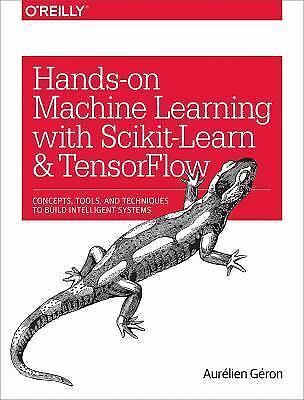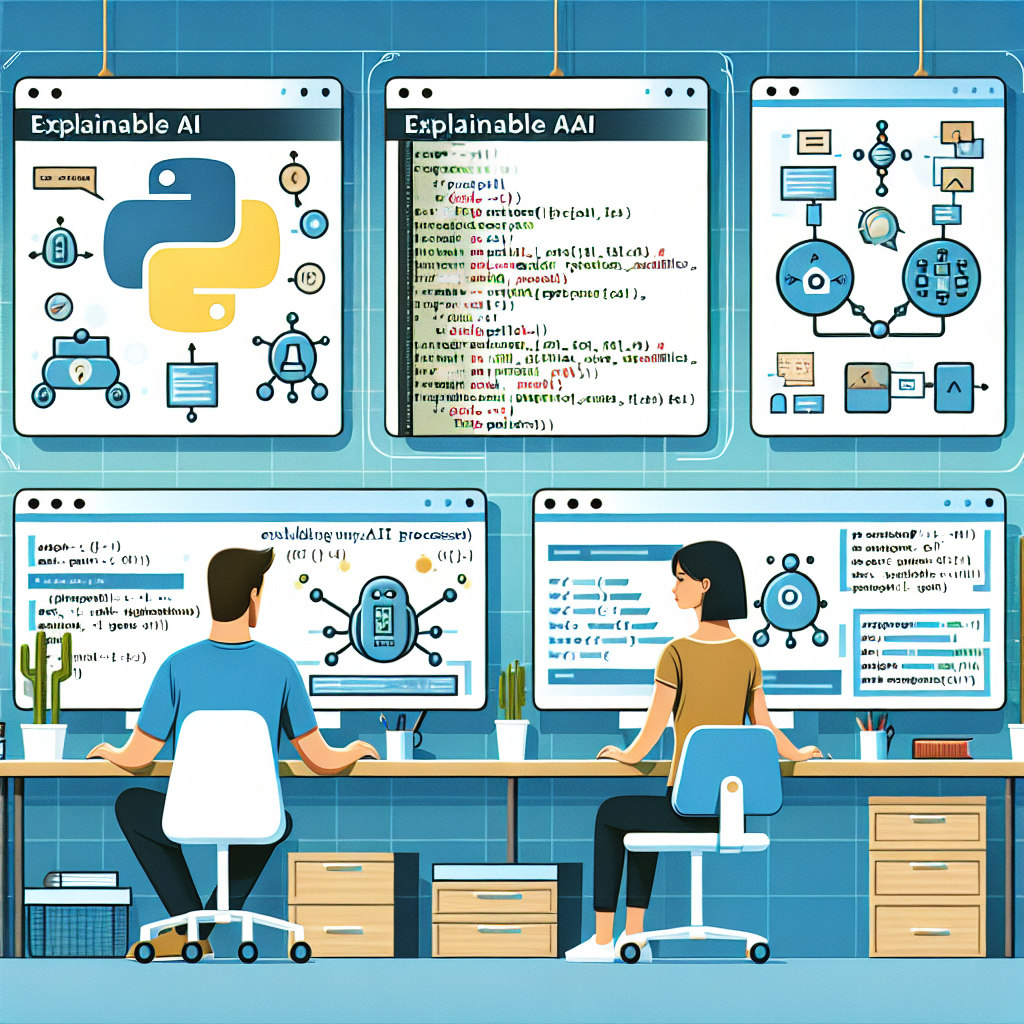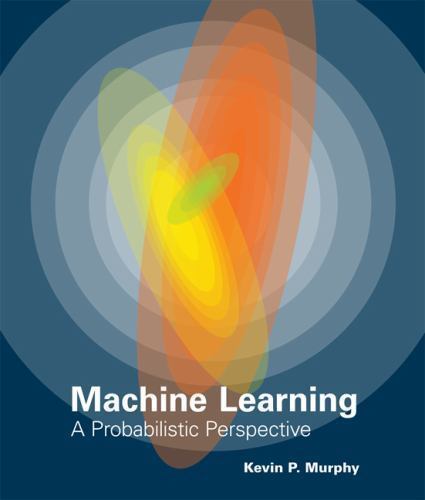Your cart is currently empty!
Tag: Approach

Enhancing Chatbots and Language Models with Deep Reinforcement Learning: A Python Approach
Chatbots and language models have become increasingly popular in the field of artificial intelligence, with applications ranging from customer service to language translation. However, while these models have made significant advancements in recent years, they still face challenges in understanding and generating human-like responses. One approach to improving the performance of chatbots and language models is through deep reinforcement learning, a branch of machine learning that focuses on training intelligent agents to make sequential decisions.In this article, we will explore how deep reinforcement learning can be used to enhance chatbots and language models, with a focus on a Python-based approach. We will discuss the basic principles of deep reinforcement learning, as well as specific techniques that can be applied to improve the performance of chatbots and language models.
Deep reinforcement learning is a powerful framework for training intelligent agents to learn optimal decision-making policies through trial and error. In the context of chatbots and language models, this means training the model to generate more coherent and relevant responses by rewarding it for producing high-quality output.
One common technique for enhancing chatbots and language models with deep reinforcement learning is through the use of reward shaping. Reward shaping involves designing a reward function that provides feedback to the model based on the quality of its output. For example, a chatbot could be rewarded for generating responses that are both grammatically correct and contextually relevant to the conversation.
Another key technique for enhancing chatbots and language models is through the use of policy gradient methods. Policy gradient methods involve training the model to maximize the expected reward by adjusting its policy parameters. This can be done through techniques such as the REINFORCE algorithm, which updates the model’s parameters based on the gradient of the expected reward.
In addition to reward shaping and policy gradient methods, there are a variety of other techniques that can be used to enhance chatbots and language models with deep reinforcement learning. These include techniques such as actor-critic methods, which combine the advantages of both policy gradient and value-based methods, as well as deep Q-learning, which uses a neural network to estimate the value of actions in a given state.
To implement these techniques in a Python-based approach, developers can leverage popular deep learning frameworks such as TensorFlow or PyTorch. These frameworks provide a wide range of tools and libraries for building and training deep reinforcement learning models, making it easier for developers to experiment with different techniques and optimize the performance of their chatbots and language models.
In conclusion, deep reinforcement learning offers a powerful framework for enhancing the performance of chatbots and language models. By applying techniques such as reward shaping, policy gradient methods, and actor-critic methods, developers can train more intelligent and responsive models that are better equipped to understand and generate human-like responses. With the growing popularity of chatbots and language models in various applications, deep reinforcement learning is poised to play a key role in advancing the field of artificial intelligence.
#Enhancing #Chatbots #Language #Models #Deep #Reinforcement #Learning #Python #Approach,deep reinforcement learning with python: rlhf for chatbots and large
language models
Machine Learning: A Quantitative Approach

Machine Learning: A Quantitative Approach
Price : 24.99
Ends on : N/A
View on eBay
Machine Learning: A Quantitative ApproachMachine learning has revolutionized the way we approach complex problems in various fields such as finance, healthcare, marketing, and more. One approach to machine learning is through a quantitative lens, where algorithms are used to analyze data and make predictions based on statistical models.
In this post, we will explore the concept of machine learning from a quantitative perspective, focusing on the mathematical and statistical techniques used to develop and evaluate machine learning models. We will discuss the importance of data preprocessing, feature selection, model training, and evaluation in building robust machine learning systems.
Furthermore, we will delve into different types of machine learning algorithms such as supervised learning, unsupervised learning, and reinforcement learning, and how they can be applied to solve real-world problems. We will also touch upon the role of optimization techniques in fine-tuning machine learning models for optimal performance.
Overall, this post aims to provide a comprehensive overview of machine learning from a quantitative approach, highlighting the importance of data-driven decision-making and the power of algorithms in extracting valuable insights from complex datasets. Stay tuned for more insights into the fascinating world of machine learning!
#Machine #Learning #Quantitative #Approach,machine learning: an applied mathematics introduction
Understanding Model Decisions with Python: A Hands-On XAI Approach
Understanding Model Decisions with Python: A Hands-On XAI ApproachIn the world of machine learning and artificial intelligence, the ability to interpret and understand the decisions made by models is crucial for ensuring transparency, accountability, and trustworthiness. This is where eXplainable AI (XAI) techniques come into play, providing insights into how models arrive at their predictions or classifications.
In this article, we will explore how to implement XAI techniques using Python, a popular programming language for data science and machine learning. By following a hands-on approach, we will demonstrate how to interpret model decisions and gain a better understanding of how machine learning models work.
1. What is eXplainable AI (XAI)?
eXplainable AI (XAI) refers to a set of techniques and methods that aim to make the decisions of machine learning models more transparent and interpretable. This is especially important in applications where the decisions made by models can have significant real-world consequences, such as in healthcare, finance, and criminal justice.
XAI techniques help users understand how a model arrives at a particular prediction or classification by providing explanations in a human-readable format. By gaining insights into the inner workings of a model, users can verify its correctness, identify potential biases, and improve its performance.
2. Hands-On XAI with Python
To demonstrate how to implement XAI techniques using Python, we will use the popular scikit-learn library, which provides a wide range of tools for machine learning. In particular, we will focus on two common XAI techniques: feature importance and SHAP (SHapley Additive exPlanations).
Feature importance is a simple and intuitive way to understand the relative importance of each feature in a model. By analyzing the contribution of individual features to the model’s predictions, we can gain insights into which factors are driving the decisions made by the model.
SHAP, on the other hand, is a more advanced technique that provides a unified framework for interpreting the predictions of any machine learning model. By calculating the Shapley values for each feature, SHAP can explain the contribution of each feature to the final prediction in a model-agnostic way.
3. Example: Interpreting a Random Forest Model
To demonstrate how to interpret the decisions of a machine learning model using Python, let’s consider a simple example with a Random Forest classifier. We will use the famous Iris dataset, which contains information about the sepal and petal dimensions of three different species of flowers.
First, we will train a Random Forest classifier on the Iris dataset using scikit-learn:
“`python
from sklearn.ensemble import RandomForestClassifier
from sklearn.datasets import load_iris
from sklearn.model_selection import train_test_split
# Load the Iris dataset
iris = load_iris()
X, y = iris.data, iris.target
# Split the dataset into training and testing sets
X_train, X_test, y_train, y_test = train_test_split(X, y, test_size=0.2, random_state=42)
# Train a Random Forest classifier
clf = RandomForestClassifier(n_estimators=100)
clf.fit(X_train, y_train)
“`
Next, we can use the feature importance attribute of the trained Random Forest classifier to understand which features are most important for making predictions:
“`python
import matplotlib.pyplot as plt
# Get feature importances
importances = clf.feature_importances_
# Sort feature importances in descending order
indices = np.argsort(importances)[::-1]
# Plot feature importances
plt.figure()
plt.title(“Feature importances”)
plt.bar(range(X.shape[1]), importances[indices])
plt.xticks(range(X.shape[1]), indices)
plt.show()
“`
By visualizing the feature importances, we can see which features are most important for predicting the species of flowers in the Iris dataset. This information can help us understand the underlying patterns in the data and improve the performance of the model.
4. Conclusion
In this article, we have explored how to interpret the decisions of machine learning models using Python and XAI techniques. By following a hands-on approach with a Random Forest classifier on the Iris dataset, we have demonstrated how to calculate feature importances and gain insights into the inner workings of the model.
As machine learning models become increasingly complex and ubiquitous, the need for transparent and interpretable AI becomes more important than ever. By using XAI techniques like feature importance and SHAP in Python, we can ensure that our models are trustworthy, accountable, and fair.
In future work, we can further explore advanced XAI techniques and apply them to more complex machine learning models and datasets. By continuing to prioritize transparency and interpretability in AI, we can build more reliable and ethical systems that benefit society as a whole.
#Understanding #Model #Decisions #Python #HandsOn #XAI #Approach,hands-on explainable ai (xai) with python
Mastering XAI with Python: A Practical Approach to Explainable AI
Mastering XAI with Python: A Practical Approach to Explainable AIExplainable Artificial Intelligence (XAI) has become a crucial aspect in the development and deployment of AI systems. It is essential to understand how AI models make decisions in order to ensure transparency, accountability, and trustworthiness. Python, being one of the most popular programming languages in the AI and machine learning community, offers a wide range of tools and libraries for implementing XAI techniques.
In this article, we will explore how to master XAI with Python through a practical approach. We will discuss the importance of XAI, the various techniques and tools available in Python, and how to implement them in your AI projects.
Why is XAI important?
XAI is important for several reasons. Firstly, it helps in understanding and interpreting the decisions made by AI models. This is crucial for ensuring that the decisions are fair, unbiased, and free from any ethical issues. Secondly, XAI enables users to trust and rely on AI systems, knowing how they arrive at their conclusions. Finally, XAI can also help in debugging and improving the performance of AI models by identifying potential weaknesses and areas for improvement.
Techniques and tools for XAI in Python
Python offers a wide range of tools and libraries for implementing XAI techniques. Some of the popular ones include:
1. SHAP (SHapley Additive exPlanations): SHAP is a popular library for interpreting machine learning models. It provides explanations for individual predictions by computing Shapley values, which represent the contribution of each feature to the model’s prediction.
2. Lime: Lime is another popular library for explaining the predictions of machine learning models. It generates local explanations by perturbing the input data and observing how the model’s predictions change.
3. ELI5: ELI5 is a library that provides explanations for machine learning models using a variety of techniques, such as permutation importance and feature importance.
4. Interpretable Machine Learning: Interpretable Machine Learning is a library that provides a collection of tools for interpreting machine learning models, such as feature importance plots and partial dependence plots.
Implementing XAI techniques in Python
To implement XAI techniques in Python, you can follow these steps:
1. Install the necessary libraries: Start by installing the required libraries, such as SHAP, Lime, ELI5, and Interpretable Machine Learning.
2. Load your AI model: Load your trained AI model using a library such as scikit-learn or TensorFlow.
3. Generate explanations: Use the XAI libraries to generate explanations for individual predictions or the overall behavior of the model.
4. Visualize the explanations: Visualize the explanations using plots, tables, or other visualization techniques to better understand the model’s decisions.
5. Fine-tune your model: Use the insights gained from the explanations to fine-tune your AI model and improve its performance.
In conclusion, mastering XAI with Python is essential for building transparent, accountable, and trustworthy AI systems. By understanding how AI models make decisions and implementing XAI techniques, you can ensure that your AI projects are ethical, fair, and reliable. With the wide range of tools and libraries available in Python, implementing XAI techniques has never been easier. So, start mastering XAI with Python today and take your AI projects to the next level.
#Mastering #XAI #Python #Practical #Approach #Explainable,hands-on explainable ai (xai) with python
Exploring the Principles of Machine Learning: A Multi-Perspective Approach
Machine learning is a rapidly growing field that has the potential to revolutionize how we use and understand data. From self-driving cars to personalized recommendations on streaming services, machine learning algorithms are being used in a wide range of applications to make our lives easier and more efficient. However, understanding how these algorithms work can be a daunting task for those unfamiliar with the field.One approach to demystifying machine learning is to explore its principles from multiple perspectives. By examining the core concepts of machine learning from different angles, we can gain a more comprehensive understanding of how these algorithms operate and how they can be applied in real-world scenarios.
One key principle of machine learning is the concept of supervised learning, where the algorithm is trained on a labeled dataset to make predictions on new, unseen data. This approach is commonly used in tasks such as image recognition and natural language processing, where the algorithm learns to identify patterns in the data and make accurate predictions based on those patterns.
Another important principle of machine learning is unsupervised learning, where the algorithm is given an unlabeled dataset and tasked with finding patterns and relationships within the data on its own. This approach is often used in tasks such as clustering and anomaly detection, where the algorithm can uncover hidden insights in the data that may not be apparent to human analysts.
Reinforcement learning is another key principle of machine learning, where the algorithm learns to make decisions by interacting with its environment and receiving feedback on its actions. This approach is commonly used in tasks such as game playing and robotics, where the algorithm learns to optimize its behavior based on the rewards it receives for its actions.
By exploring these principles of machine learning from multiple perspectives, we can gain a deeper understanding of how these algorithms work and how they can be applied in different contexts. By understanding the core concepts of machine learning, we can harness the power of these algorithms to solve complex problems and drive innovation in a wide range of fields.
In conclusion, exploring the principles of machine learning from a multi-perspective approach can help demystify this rapidly growing field and enable us to leverage the power of these algorithms in new and exciting ways. By understanding the core concepts of supervised learning, unsupervised learning, and reinforcement learning, we can unlock the potential of machine learning to transform how we use and understand data in the modern world.
#Exploring #Principles #Machine #Learning #MultiPerspective #Approach,principles of machine learning: the three perspectives
The Tripartite Approach to Understanding Machine Learning Principles
Machine learning is a rapidly growing field that aims to teach computers how to learn and make decisions without being explicitly programmed. There are many different approaches and techniques that can be used to achieve this goal, but one popular and effective method is the tripartite approach.The tripartite approach to understanding machine learning principles involves breaking down the learning process into three main components: representation, evaluation, and optimization. By focusing on these three key aspects, researchers and developers can gain a deeper understanding of how machine learning algorithms work and how to improve their performance.
Representation refers to the way in which data is encoded and structured in order to be processed by a machine learning algorithm. This includes selecting the appropriate features to use, as well as determining how to represent these features in a way that is meaningful and useful for the algorithm. Choosing the right representation can have a significant impact on the accuracy and efficiency of a machine learning model.
Evaluation is the process of assessing the performance of a machine learning algorithm by comparing its predictions to the actual outcomes. This involves using metrics such as accuracy, precision, recall, and F1 score to determine how well the algorithm is able to make accurate predictions on unseen data. By evaluating the performance of a model, researchers can identify areas for improvement and make adjustments to enhance its effectiveness.
Optimization involves fine-tuning the parameters and hyperparameters of a machine learning algorithm in order to improve its performance. This can involve adjusting the learning rate, regularization parameters, and other settings to optimize the model for a specific task or dataset. By optimizing the parameters of a model, researchers can improve its accuracy and efficiency, leading to better results in real-world applications.
Overall, the tripartite approach to understanding machine learning principles provides a comprehensive framework for developing and improving machine learning algorithms. By focusing on representation, evaluation, and optimization, researchers can gain a deeper understanding of how machine learning models work and how to enhance their performance. This approach can help to drive innovation in the field of machine learning and lead to the development of more advanced and effective algorithms for a wide range of applications.
#Tripartite #Approach #Understanding #Machine #Learning #Principles,principles of machine learning: the three perspectives
Machine Learning: A Quantitative Approach

Machine Learning: A Quantitative Approach
Price : 18.48
Ends on : N/A
View on eBay
Machine Learning: A Quantitative ApproachMachine learning is a rapidly growing field that leverages data and algorithms to enable computers to learn and make decisions without being explicitly programmed. In recent years, there has been a shift towards a more quantitative approach to machine learning, where mathematical and statistical techniques are used to analyze and model data.
Quantitative methods play a crucial role in machine learning by providing a framework for understanding and evaluating the performance of machine learning algorithms. Techniques such as regression analysis, hypothesis testing, and optimization are used to develop and fine-tune models that can accurately predict outcomes and make informed decisions.
By taking a quantitative approach to machine learning, researchers and practitioners are able to gain deeper insights into the underlying patterns and relationships in data, leading to more robust and reliable models. This approach also allows for the development of more sophisticated algorithms that can handle complex and large-scale datasets.
Overall, a quantitative approach to machine learning offers a systematic and rigorous way to analyze and interpret data, leading to more accurate predictions and better decision-making. As the field continues to evolve, incorporating quantitative methods will be essential for advancing the capabilities of machine learning systems.
#Machine #Learning #Quantitative #Approach,principles of machine learning: the three perspectives
New Orleans Under Tornado Threat as Severe Storms Approach
New Orleans residents are bracing themselves for severe weather as tornado threats loom over the city. The National Weather Service has issued a tornado watch for the area as severe storms approach, bringing with them the potential for damaging winds, hail, and tornadoes.The threat of tornadoes is a serious concern for residents of New Orleans, as the city is no stranger to severe weather. In 2005, Hurricane Katrina devastated the city, causing widespread destruction and loss of life. Since then, residents have been vigilant about preparing for extreme weather events, and the impending tornado threat is no exception.
Emergency officials are urging residents to take precautions and stay informed about the weather conditions. They recommend having a plan in place in case of a tornado, including knowing where to seek shelter and having emergency supplies on hand.
In addition to the tornado threat, the severe storms approaching New Orleans also bring the potential for flash flooding. With heavy rain expected, residents are advised to avoid driving through flooded areas and to stay indoors until the weather passes.
Despite the looming threat of severe weather, the resilient spirit of New Orleans residents shines through. Many are coming together to support one another and ensure that everyone stays safe during the storm.
As the city prepares for the approaching severe weather, it is important for residents to stay informed, take precautions, and look out for one another. By working together and staying vigilant, New Orleans can weather the storm and emerge stronger on the other side.
#Orleans #Tornado #Threat #Severe #Storms #Approach,severe storms could bring a tornado risk to new orleans on saturday.
User-Centered Web Site Development: A Human-Computer Interaction Approach

User-Centered Web Site Development: A Human-Computer Interaction Approach
Price : 5.38
Ends on : N/A
View on eBay
User-Centered Web Site Development: A Human-Computer Interaction ApproachIn today’s digital age, creating a user-friendly and engaging website is more important than ever. User-centered web site development is a process that focuses on the needs and preferences of the end users, ensuring that they have a positive experience when interacting with the site.
One approach to user-centered web site development is through the lens of human-computer interaction (HCI). HCI is a multidisciplinary field that focuses on the design, evaluation, and implementation of interactive computing systems for human use. By applying HCI principles to web site development, designers can create websites that are intuitive, easy to navigate, and visually appealing.
When using a human-computer interaction approach to web site development, designers should consider the following key principles:
1. User research: Conducting user research is essential to understanding the needs and preferences of the target audience. This can be done through surveys, interviews, and usability testing to gather insights on how users interact with the site.
2. User-centered design: Designing with the user in mind is crucial for creating a website that is intuitive and easy to use. This involves creating user personas, wireframing, and prototyping to ensure that the design meets the needs of the target audience.
3. Usability testing: Testing the website with real users is an important step in the development process. By observing how users interact with the site and gathering feedback, designers can identify areas for improvement and make necessary adjustments.
4. Accessibility: Ensuring that the website is accessible to all users, including those with disabilities, is a key aspect of user-centered web site development. This involves following web accessibility guidelines and using techniques such as alt text for images and keyboard navigation.
By taking a human-computer interaction approach to web site development, designers can create websites that are user-friendly, engaging, and accessible to a wide range of users. By putting the needs of the user first, companies can create a positive online experience that builds trust and loyalty with their target audience.
#UserCentered #Web #Site #Development #HumanComputer #Interaction #Approach, data center
Motivational Design for Learning and Performance: The ARCS Model Approach
Price: $109.99
(as of Dec 30,2024 03:07:50 UTC – Details)
Publisher : Springer; 2010th edition (May 25, 2010)
Language : English
Paperback : 364 pages
ISBN-10 : 1441965793
ISBN-13 : 978-1441965790
Item Weight : 1.2 pounds
Dimensions : 6.1 x 0.86 x 9.25 inches
Motivational Design for Learning and Performance: The ARCS Model ApproachMotivation is a key factor in driving individuals to learn and perform at their best. In the field of instructional design, the ARCS model provides a comprehensive framework for creating motivational learning experiences. The ARCS model, developed by John Keller, focuses on four key components: attention, relevance, confidence, and satisfaction.
Attention is the first step in motivating learners. Designers can capture learners’ attention through the use of multimedia, interactive activities, and engaging content. By piquing learners’ curiosity and interest, designers can create a positive learning environment that encourages active engagement.
Relevance is the next component of the ARCS model. Learners are more likely to be motivated when they see the relevance of the material to their own lives and goals. Designers can enhance relevance by presenting real-world examples, connecting concepts to learners’ experiences, and highlighting the practical applications of the content.
Confidence plays a crucial role in motivating learners to tackle challenging tasks. Designers can boost learners’ confidence by providing clear instructions, offering opportunities for practice and feedback, and scaffolding learning activities to gradually increase complexity. By fostering a sense of self-efficacy, designers can empower learners to take on new challenges and persist in their efforts.
Satisfaction is the final component of the ARCS model. Learners are more likely to be motivated when they feel a sense of accomplishment and fulfillment. Designers can enhance satisfaction by providing opportunities for learners to demonstrate their mastery, receive recognition for their achievements, and reflect on their progress. By celebrating successes and acknowledging growth, designers can reinforce learners’ motivation and inspire them to continue learning and performing at their best.
In conclusion, the ARCS model offers a valuable framework for creating motivational design in learning and performance contexts. By focusing on attention, relevance, confidence, and satisfaction, designers can inspire learners to engage with content, see the value in their learning experiences, build their confidence, and find fulfillment in their achievements. By incorporating the principles of the ARCS model into their design practices, instructional designers can create engaging, effective, and motivating learning experiences that drive performance and foster lifelong learning.
#Motivational #Design #Learning #Performance #ARCS #Model #Approach,arc b580 vr performance
